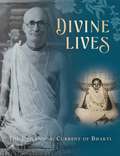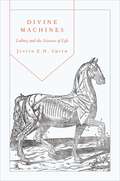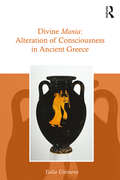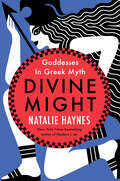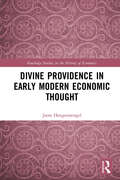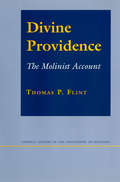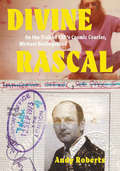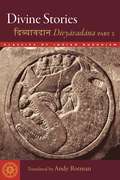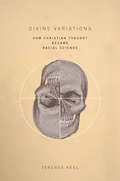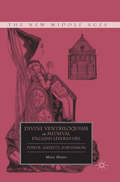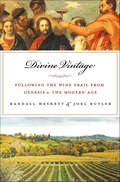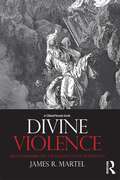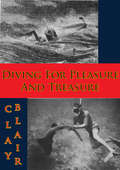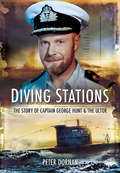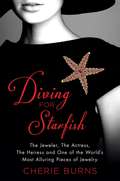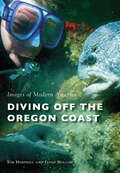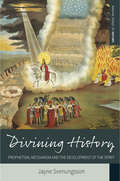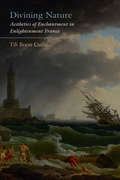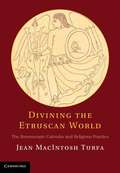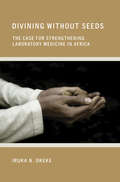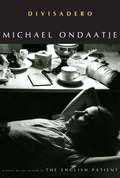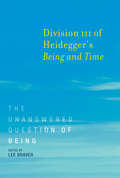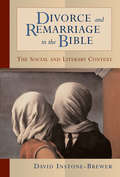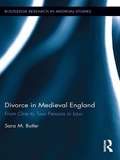- Table View
- List View
Divine Lives: The Descending Current of Bhakti
by Mandala PublishingDivine Lives recounts the lives and teachings of the venerated spiritual masters His Divine Grace Srila Prabhupada Bhakti Siddhanta Sarasvati Gosvami Thakura, the founder acarya of the entire Gaudiya community, and His Divine Grace Srila Bhakti Pramode Puri Gosvami Thakura, the founding acarya of Sri Gopinatha Gaudiya Matha. The Gaudiya Vaisnava tradition stresses the importance for spiritual seekers to receive transcendental knowledge in a bona-fide current of devotion. Genuine spiritual teachers retain the power and glory of this divine flow in their hearts and manifest it through their unadulterated words and proper conduct. Divine Lives highlights the descriptions of two such sublime personalities, His Divine Grace Srila Prabhupada Bhakti Siddhanta Sarasvati Gosvami Thakura, and his disciple, His Divine Grace Srila Bhakti Pramode Puri Gosvami Thakura. In the time of the Gaudiya revolution led by Srila Prabhupada, Srila B. P. Puri Goswami carried a pen and paper wherever he went. His impeccable notes from that time will surely be of great service for many generations to come. Some of his writings are included within in the form of heart-touching glorifications to his spiritual master that have been organized into separate categories for the reader's benefit. After the biography of Srila Prabhupada and an autobiography of Srila B. P. Puri Goswami, Divine Lives concludes with the words of Srila B. P. Puri Goswami Thakura&’s successor and disciple, Srila B. B. Bodhayan Maharaja. In this last section, we learn specific details about Srila B. P. Puri Goswami&’s first meetings with Srila Prabhupada and how he joined this spiritual movement. Also included within are historical articles from the Gaudiya and Chaitanya Vani that have been translated from the original Bengali into English for the first time, as well as rare photos and artifacts from this transformational time in Gaudiya history.
Divine Machines: Leibniz and the Sciences of Life
by Justin Smith-RuiuThough it did not yet exist as a discrete field of scientific inquiry, biology was at the heart of many of the most important debates in seventeenth-century philosophy. Nowhere is this more apparent than in the work of G. W. Leibniz. In Divine Machines, Justin Smith offers the first in-depth examination of Leibniz's deep and complex engagement with the empirical life sciences of his day, in areas as diverse as medicine, physiology, taxonomy, generation theory, and paleontology. He shows how these wide-ranging pursuits were not only central to Leibniz's philosophical interests, but often provided the insights that led to some of his best-known philosophical doctrines. Presenting the clearest picture yet of the scope of Leibniz's theoretical interest in the life sciences, Divine Machines takes seriously the philosopher's own repeated claims that the world must be understood in fundamentally biological terms. Here Smith reveals a thinker who was immersed in the sciences of life, and looked to the living world for answers to vexing metaphysical problems. He casts Leibniz's philosophy in an entirely new light, demonstrating how it radically departed from the prevailing models of mechanical philosophy and had an enduring influence on the history and development of the life sciences. Along the way, Smith provides a fascinating glimpse into early modern debates about the nature and origins of organic life, and into how philosophers such as Leibniz engaged with the scientific dilemmas of their era.
Divine Mania: Alteration of Consciousness in Ancient Greece
by Yulia Ustinova‘Our greatest blessings come to us by way of mania, provided it is given us by divine gift,’ – says Socrates in Plato’s Phaedrus. Certain forms of alteration of consciousness, considered to be inspired by supernatural forces, were actively sought in ancient Greece. Divine mania comprises a fascinating array of diverse experiences: numerous initiates underwent some kind of alteration of consciousness during mystery rites; sacred officials and inquirers attained revelations in major oracular centres; possession states were actively sought; finally, some thinkers, such as Pythagoras and Socrates, probably practiced manipulation of consciousness. These experiences, which could be voluntary or involuntary, intense or mild, were interpreted as an invasive divine power within one’s mind, or illumination granted by a super-human being. Greece was unique in its attitude to alteration of consciousness. From the perspective of individual and public freedom, the prominent position of the divine mania in Greek society reflects its acceptance of the inborn human proclivity to experience alteration of consciousness, interpreted in positive terms as god-sent. These mental states were treated with cautious respect, and in contrast to the majority of complex societies, ancient and modern, were never suppressed or pushed to the cultural and social periphery.
Divine Might: Goddesses in Greek Myth
by Natalie HaynesNew York Times bestselling author Natalie Haynes returns to the world of ancient Greek myth in this scintillating follow-up to Pandora’s Jar.Few writers today have reshaped our view of the ancient Greek myths more than revered bestselling author Natalie Haynes. Divine Might is a female-centered look at Olympus and the Furies, focusing on the goddesses whose prowess, passions, jealousies, and desires rival those of their male kin, including:Athene, who sprang fully formed from her father’s brow (giving Zeus a killer headache in the process), the goddess of war and provider of wise counsel.Aphrodite, born of the foam (and sperm released from a Titan’s castrated testicles), the most beautiful of all the Olympian goddesses, the epitome of love who dispenses desire and inspires longing—yet harbors a fearsome vengeful side, doling out brutal punishments to those who displease her.Hera, Zeus’s long-suffering wife, whose jealousy born of his repeated dalliances with mortals, nymphs, and other goddesses, leads her to wreak elaborate and often painful revenge on those she believes have wronged her. (Well, wouldn’t you?)Demeter, goddess of the harvest and mother of Persephone; Artemis, the hunter and goddess of wild spaces; the Muses, the nine daughters of Zeus and Mnemosyne, the goddess of memory; and Hestia, goddess of domesticity and sacrificial fire.Infused with Haynes’s engaging charm and irrepressible wit, Divine Might is a refreshing take on the legends and stories we thought we knew.
Divine Providence in Early Modern Economic Thought (Routledge Studies in the History of Economics)
by Joost HengstmengelIn this important volume, Joost Hengstmengel examines the doctrine of divine providence and how it served as explanation and justification in economic debates in the sixteenth, seventeenth and eighteenth centuries throughout Western Europe. The author discusses five different areas in which God was associated with the economy: international trade, division of labour, value and price, self-interest, and poverty and inequality. Ultimately, it is shown that theological ideas continued to influence economic thought beyond the Medieval period, and that the science of economics as we know it today has theological origins. Interdisciplinary in nature, this book will be of interest to advanced students and researchers in the history of economic thought, the history of theology, philosophy and intellectual history.
Divine Providence: The Molinist Account (Cornell Studies in the Philosophy of Religion)
by Thomas P. FlintThomas P. Flint develops and defends the idea of divine providence sketched by Luis de Molina, the sixteenth-century Jesuit theologian. The Molinist account of divine providence reconciles two claims long thought to be incompatible: that God is the all-knowing governor of the universe and that individual freedom can prevail only in a universe free of absolute determinism. The Molinist concept of middle knowledge holds that God knows, though he has no control over, truths about how any individual would freely choose to act in any situation, even if the person never encounters that situation. Given such knowledge, God can be truly providential while leaving his creatures genuinely free. Divine Providence is by far the most detailed and extensive presentation of the Molinist view ever written.Middle knowledge is hotly debated in philosophical theology, and the controversy spills over into metaphysics and moral philosophy as well. Flint ably defends the concept against its most influential contemporary critics, and shows its importance to Christian practice. With particular originality and sophistication, he applies Molinism to such aspects of providence as prayer, prophecy, and the notion of papal infallibility, teasing out the full range of implications for traditional Christianity.
Divine Rascal: On the Trail of LSD's Cosmic Courier, Michael Hollingshead
by Andy RobertsA biography of a key figure in psychedelic history: the man who turned Timothy Leary on to LSD.Of all the figures associated with the history of LSD there is none more enigmatic than Michael Hollingshead. Appearing as if from nowhere, he turned Timothy Leary on to LSD in 1962, and was influential in Leary's years at Harvard, Millbrook, and beyond. A Zelig-like character, Hollingshead was a key player in London's early LSD scene. In 1965 he went to London to establish a cultural beachhead for Leary's LSD philosophy at the World Psychedelic Centre in Chelsea. Following a spell in prison, where he dosed KGB spy George Blake, he continued to pursue adventures with the Brotherhood of Eternal Love, established a psychedelic commune, created the first electronic I Ching installation, published an underground magazine, and spent time in Nepal, before dying a mysterious death in Bolivia in the 1980s.Psychedelic trickster guru, or conman and charlatan? Exactly who Hollingshead was and what his motives were remain unclear. Some believed he was working for the secret services, others that he was just a Leary wannabe, his aspirations destroyed by his deviant personality and addiction to alcohol and opiates. Divine Rascal is the first reliable biography of one of psychedelia's key figures, without whom the trajectory of LSD in the world would have been radically different.
Divine Stories: Divyavadana, Part 2
by Andy RotmanExplore this second volume of translations, in vivid prose, from one of the most celebrated collections of ancient Buddhist stories.Actions never come to naught, even after hundreds of millions of years. When the right conditions gather and the time is right, then they will have their effect on embodied beings. Ancient Buddhist literature is filled with tales of past lives. The Buddha, surrounded by his followers, is asked how it came to be that a certain person has met a particular fate. With his omniscience, the Buddha looks into eons past and uncovers the events that led to the present outcome and foretells the future as well. With stories of wicked wives, patricidal princes, and shape-shifting serpents, Divine Stories offers a fascinating illustration of the law of karma—the truth that the power of good and bad deeds is never lost. These are some of the oldest Buddhist tales ever committed to writing, illuminating the culture of northern India in the early centuries of the common era and bringing to life the Buddhist values of generosity and faith. Andy Rotman’s evocative translation combines accuracy with readability, with detailed editorial notes comparing readings in various Sanskrit, Pali, and Tibetan sources. Divine Stories is a major contribution to Indian and Buddhist studies.
Divine Variations: How Christian Thought Became Racial Science
by Terence KeelDivine Variations offers a new account of the development of scientific ideas about race. Focusing on the production of scientific knowledge over the last three centuries, Terence Keel uncovers the persistent links between pre-modern Christian thought and contemporary scientific perceptions of human difference. He argues that, instead of a rupture between religion and modern biology on the question of human origins, modern scientific theories of race are, in fact, an extension of Christian intellectual history. Keel's study draws on ancient and early modern theological texts and biblical commentaries, works in Christian natural philosophy, seminal studies in ethnology and early social science, debates within twentieth-century public health research, and recent genetic analysis of population differences and ancient human DNA. From these sources, Keel demonstrates that Christian ideas about creation, ancestry, and universalism helped form the basis of modern scientific accounts of human diversity—despite the ostensible shift in modern biology towards scientific naturalism, objectivity, and value neutrality. By showing the connections between Christian thought and scientific racial thinking, this book calls into question the notion that science and religion are mutually exclusive intellectual domains and proposes that the advance of modern science did not follow a linear process of secularization.
Divine Ventriloquism in Medieval English Literature
by Mary HayesA study of medieval attitudes towards the ventriloquism of God's and Christ's voices through human media, which reveals a progression from an orthodox view of divine vocal power to an anxiety over the authority of the priest's voice to a subversive take on the divine voice that foreshadows Protestant devotion.
Divine Vintage: Following the Wine Trail from Genesis to the Modern Age
by Randall Heskett Joel ButlerWinner of the Gourmand Wine Books prize for 'Best Drinks Writing Book' in the UK A fascinating journey through ancient wine country that reveals the drinking habits of early Christians, from Abraham to Jesus. Wine connoisseur Joel Butler teamed up with biblical historian Randall Heskett for a remarkable adventure that travels the biblical wine trail in order to understand what kinds of wines people were drinking 2,000 to 3,500 years ago. Along the way, they discover the origins of wine, unpack the myth of Shiraz, and learn the secrets of how wine infiltrated the biblical world. This fascinating narrative is full of astounding facts that any wine lover can take to their next tasting, including the myths of the Phoenician, Greek, Roman, and Jewish wine gods, the emergence of kosher wine, as well as the use of wine in sacrifices and other rites. It will also take a close a look at contemporary modern wines made with ancient techniques, and guide the reader to experience the wines Noah (the first wine maker!) Abraham, Moses and Jesus drank.
Divine Violence: Walter Benjamin and the Eschatology of Sovereignty
by James R. MartelDivine Violence looks at the question of political theology and its connection to sovereignty. It argues that the practice of sovereignty reflects a Christian eschatology, one that proves very hard to overcome even by left thinkers, such as Arendt and Derrida, who are very critical of it. These authors fall into a trap described by Carl Schmitt whereby one is given a (false) choice between anarchy and sovereignty, both of which are bound within—and return us to—the same eschatological envelope. In Divine Violence, the author argues that Benjamin supplies the correct political theology to help these thinkers. He shows how to avoid trying to get rid of sovereignty (the "anarchist move" that Schmitt tells us forces us to "decide against the decision") and instead to seek to de-center and dislocate sovereignty so that it’s mythological function is disturbed. He does this with the aid of divine violence, a messianic force that comes into the world to undo its own mythology, leaving nothing in its wake. Such a move clears the myths of sovereignty away, turning us to our own responsibility in the process. In that way, the author argues,Benjamin succeeds in producing an anarchism that is not bound by Schmitt’s trap but which is sustained even while we remain dazzled by the myths of sovereignty that structure our world. Divine Violence will be of interest to students of political theory, to those with an interest in political theology, philosophy and deconstruction, and to those who are interested in thinking about some of the dilemmas that the ‘left’ finds itself in today.
Diving For Pleasure And Treasure
by Clay Blair Jr.This unique book covers the author, Clay Blair Jr., and Robert Marx's diving adventures from the search for the Monitor off of Cape Hatteras, to the discovery of the Spanish treasure galleon "El Matanzero" off the coast of Yucatan. This book is also a practical guide for those skin divers who want to search for greater rewards: how to dig on a wreck and identify finds. The appendix includes extracts of 10 documents from the Archives of the Indies, in Seville, Spain, concerning the ship Nuestra Señora De Los Milagros, also known as El Matanzero.
Diving Stations: The Story of Captain George Hunt and the Ultor
by Peter DornanDiving Stations is the inspiring story of Captain George Hunts career. Born in Uganda and then educated in Glasgow, he was determined to join the Navy and at 13 years old he entered HMS Conway.His prewar years saw him serving worldwide. In 1939, on the outbreak of war he was already serving in submarines. Over the next six years he was rammed twice, sunk once and had hundred of depth charges dropped around him. He gave more than he got! While in command of the Unity Class Submarine Ultor—mainly in the Mediterranean—he and his crew accounted for an astonishing 20 enemy vessels sunk by torpedo and 8 by gunfire as well as damaging another 4 ships. His fifteenth mission was described by the Admiralty as unsurpassed in the Annals of the Mediterranean Submarine Flotilla.After the War George continued his distinguished naval career becoming Senior Naval Officer West Indies (SNOWI). He emigrated to Australia where he lives today.
Diving for Starfish: The Jeweler, the Actress, the Heiress, and One of the World's Most Alluring Pieces of Jewelry
by Cherie BurnsIn the mid 1930s, in the workroom of the famous Parisian jeweler Boivin, a young jewelry designer named Juliette Moutard created one of the most coveted pieces of jewelry in the world—the famous starfish pin—still sought after today by aficionados of fine jewelry. The starfish, created out of gold and encrusted with 71 cabochon rubies and 241 small amethysts, was distinctive because its five rays were articulated, meaning that they could curl and conform to the bustline or shoulder of the women who wore it. The House of Boivin made three of them. Two of the women who bought and wore the starfish were Claudette Colbert and Millicent Rogers. Obsessed with the pin after she saw it in the private showroom of a Manhattan jewelry merchant, Cherie Burns set off on a journey to find out all she could about the elusive pins and the women who owned them. Her search took her around the world to Paris, London, New York, and Hollywood. Diving for Starfish is the story of these marvelous pieces of jewelry and the equally dazzling women who loved them.
Diving off the Oregon Coast (Images of Modern America)
by Tom Hemphill Floyd HolcomThe Oregon Coast is well known for its beauty. The rugged coastline with its constant wave and surf action provides the calming sounds of the ocean that all can hear, but a diver also sees the giant kelp forests and gets excited about the promise of abundant marine life, brilliantly colored anemone, sponges, cute little reef fish and huge ling cod, large plate-sized rock scallops, abalone, giant Pacific octopus, and friendly wolf eel. This is truly a diver's paradise. There are no stories of skin divers prior to World War II, but with the development of rubber dry suits and neoprene wetsuits in the early 1950s, divers began to explore the reefs out past the surf and in protected coves near the shoreline. Images of Modern America: Diving off the Oregon Coast showcases the images of a few diving pioneers, early and current dive stores, the beautiful coastline, and the colorful world underwater.
Divining History: Prophetism, Messianism and the Development of the Spirit (Making Sense of History #26)
by Jayne SvenungssonFor millennia, messianic visions of redemption have inspired men and women to turn against unjust and oppressive orders. Yet these very same traditions are regularly decried as antecedents to the violent and authoritarian ideologies of modernity. Informed in equal parts by theology and historical theory, this book offers a provocative exploration of this double-edged legacy. Author Jayne Svenungsson rigorously pursues a middle path between utopian arrogance and an enervated postmodernism, assessing the impact of Jewish and Christian theologies of history on subsequent thinkers, and in the process identifying a web of spiritual and intellectual motifs extending from ancient Jewish prophets to contemporary radicals such as Giorgio Agamben and Slavoj Zizek.
Divining Nature: Aesthetics of Enchantment in Enlightenment France
by Tili Boon CuilléThe Enlightenment remains widely associated with the rise of scientific progress and the loss of religious faith, a dual tendency that is thought to have contributed to the disenchantment of the world. In her wide-ranging and richly illustrated book, Tili Boon Cuillé questions the accuracy of this narrative by investigating the fate of the marvelous in the age of reason. Exploring the affinities between the natural sciences and the fine arts, Cuillé examines the representation of natural phenomena—whether harmonious or discordant—in natural history, painting, opera, and the novel from Buffon and Rameau to Ossian and Staël. She demonstrates that philosophical, artistic, and emotional responses to the "spectacle of nature" in eighteenth-century France included wonder, enthusiasm, melancholy, and the "sentiment of divinity." These "passions of the soul," traditionally associated with religion and considered antithetical to enlightenment, were linked to the faculties of reason, imagination, and memory that structured Diderot's Encyclopédie and to contemporary theorizations of the sublime. As Cuillé reveals, the marvelous was not eradicated but instead preserved through the establishment and reform of major French cultural institutions dedicated to science, art, religion, and folklore that were designed to inform, enchant, and persuade. This book has been made possible in part by the National Endowment for the Humanities: Exploring the human endeavor.
Divining Slavery and Freedom: The Story of Domingos Sodré, an African Priest in Nineteenth-Century Brazil (New Approaches to the Americas)
by João José ReisSince its original publication in Portuguese in 2008, this first English translation of Divining Slavery has been extensively revised and updated, complete with new primary sources and a new bibliography. It tells the story of Domingos Sodré, an African-born priest who was enslaved in Bahia, Brazil in the nineteenth century. After obtaining his freedom, Sodré became a slave owner himself, and in 1862 was arrested on suspicion for receiving stolen goods from slaves in exchange for supposed 'witchcraft.' Using this incident as a catalyst, the book discusses African religion and its place in a slave society, analyzing its double role as a refuge to blacks as well as a bridge between classes and ethnic groups (such as whites who attended African rituals and sought help from African diviners and medicine men). Ultimately, Divining Slavery explores the fluidity and relativity of conditions such as slavery and freedom, African and local religions, personal and collective experience and identities in the lives of Africans in the Brazilian diaspora. Revised and updated for the English edition (utilizes new primary sources and a new bibliography). Uses Sodré's life as a means of exploring the fluidity and relativity of conditions such as slavery and freedom, African and local religions, personal and collective experience and identities in the lives of Africans in the Brazilian diaspora. Addresses historical problems, concepts, and methods that are at the center of contemporary academic discussion.
Divining the Etruscan World
by Jean Macintosh TurfaThe Etruscan Brontoscopic Calendar is a rare document of omens foretold by thunder. It long lay hidden, embedded in a Greek translation within a Byzantine treatise from the age of Justinian. The first complete English translation of the Brontoscopic Calendar, this book provides an understanding of Etruscan Iron Age society as revealed through the ancient text, especially the Etruscans' concerns regarding the environment, food, health, and disease. Jean MacIntosh Turfa also analyzes the ancient Near Eastern sources of the Calendar and the subjects of its predictions, thereby creating a picture of the complexity of Etruscan society reaching back the before the advent of writing and the recording of the calendar.
Divining without Seeds: The Case for Strengthening Laboratory Medicine in Africa (The Culture and Politics of Health Care Work)
by Iruka N. OkekeInfectious disease is the most common cause of illness and death in Africa, yet health practitioners routinely fail to identify causative microorganisms in most patients. As a result, patients often do not receive the right medicine in time to cure them promptly even when such medicine is available, outbreaks are larger and more devastating than they should be, and the impact of control interventions is difficult to measure. Wrong prescriptions and prolonged infections amount to needless costs for patients and for health systems. In Divining without Seeds, Iruka N. Okeke forcefully argues that laboratory diagnostics are essential to the effective practice of medicine in Africa.The diversity of endemic life-threatening infections and limited public health resources in tropical Africa make the need for basic laboratory diagnostic support even more acute than in other parts of the world. This book gathers compelling case studies of inadequate diagnoses of diseases ranging from fevers—including malaria—to respiratory infections and sexually transmitted diseases. The inherited and widely prevalent health clinic model, which excludes or diminishes the hospital laboratory, is flawed, to often devastating effect. Fortunately, there are new technologies that make it possible to inexpensively implement testing at the primary care level. Divining without Seeds makes clear that routine use of appropriate diagnostic support should be part of every drug delivery plan in Africa and that diagnostic development should be given high priority.
Divisadero (Vintage International Ser.)
by Michael OndaatjeFrom the celebrated author ofThe English PatientandIn the Skin of a Lioncomes a remarkable new novel of intersecting lives that ranges across continents and time. In the 1970s in Northern California, near Gold Rush country, a father and his teenage daughters, Anna and Claire, work their farm with the help of Coop, an enigmatic young man who makes his home with them. Theirs is a makeshift family, until it is riven by an incident of violence--of both hand and heart--that sets fire to the rest of their lives. Divisaderotakes us from the city of San Francisco to the raucous backrooms of Nevada's casinos and eventually to the landscape of south-central France. It is here, outside a small rural village, that Anna becomes immersed in the life and the world of a writer from an earlier time--Lucien Segura. His compelling story, which has its beginnings at the turn of the century, circles around "the raw truth" of Anna's own life, the one she's left behind but can never truly leave. And as the narrative moves back and forth in time and place, we discover each of the characters managing to find some foothold in a present rough hewn from the past. Breathtakingly evoked and with unforgettable characters,Divisaderois a multilayered novel about passion, loss, and the unshakable past, about the often discordant demands of family, love, and memory. It is Michael Ondaatje's most intimate and beautiful novel to date. From the Hardcover edition.
Division III of Heidegger's Being and Time: The Unanswered Question of Being
by Lee BraverLeading philosophers and scholars speculate on what Heidegger's unfinished masterpiece might have said, why Heidegger didn't publish it, and what being actually means.Heidegger's Being and Time is one of the most influential and important books in the history of philosophy, but it was left unfinished. The parts we have of it, Divisions I and II of Part One, were meant to be merely preparatory for the unwritten Division III, which was to have formed the point of the entire book when it turned to the topic of being itself. In this book, leading Heidegger scholars and philosophers influenced by Heidegger take up the unanswered questions in Heidegger's masterpiece, speculating on what Division III would have said, and why Heidegger never published it. The contributors' task—to produce a secondary literature on a nonexistent primary work—seems one out of fiction by Borges or Umberto Eco. Why did Heidegger never complete Being and Time? Did he become dissatisfied with it? Did he judge it too subjectivistic, not historical enough, too individualistic, too existential? Was abandoning it part of Heidegger's “Kehre”, his supposed turning from his early work to his later work? Might Division III have offered a bridge between the two phases, if a division exists between them? And what does being mean, after all? The contributors, in search of lost Being and Time, consider these and other topics, shedding new light on Heidegger's thought.ContributorsAlain Badiou, Lee Braver, Daniel Dahlstrom, Charles Guignon, Graham Harman, Karsten Harries, Ted Kisiel, Denis McManus, Eric S. Nelson, Richard Polt, François Raffoul, Thomas Sheehan, Iain Thomson, Kate Withy, Julian Young
Divorce and Remarriage in the Bible: The Social and Literary Context
by David Instone-BrewerTo many, the New Testament's teaching on divorce and remarriage seems to be both impractical and unfair. The "plain" meaning of the texts allows for divorce only in cases of adultery or desertion, and it does not permit remarriage until the death of one's former spouse. But are these proscriptions the final word for Christians today? Are we correctly reading the scriptures that address these issues?By looking closely at the biblical texts on divorce and remarriage in light of the first-century Jewish and Greco-Roman world, this book shows that the original audience of the New Testament heard these teachings differently. Through a careful exploration of the background literature of the Old Testament, the ancient Near East, and especially ancient Judaism, David Instone-Brewer constructs a biblical view of divorce and remarriage that is wider in scope than present-day readings.Among the important findings of the book are that both Jesus and Paul condemned divorce without valid grounds and discouraged divorce even for valid grounds; that both Jesus and Paul affirmed the Old Testament grounds for divorce; that the Old Testament allowed divorce for adultery and for neglect or abuse; and that both Jesus and Paul condemned remarriage after an invalid divorce but not after a valid divorce. Instone-Brewer shows that these principles are not only different from the traditional church interpretation of the New Testament but also directly relevant to modern relationships.Enhanced with pastoral advice on how to apply the biblical teaching in today's context, this volume will be a valuable resource for anyone seeking serious answers about married life.
Divorce in Medieval England: From One to Two Persons in Law (Routledge Research in Medieval Studies #4)
by Sara M. ButlerDivorce in Medieval England is intended to reorient scholarly perceptions concerning divorce in the medieval period. Divorce, as we think of it today, is usually considered to be a modern invention. This book challenges that viewpoint, documenting the many and varied uses of divorce in the medieval period and highlighting the fact that couples regularly divorced on the grounds of spousal incompatibility. Because the medieval church was determined to uphold the sacrament of marriage whenever possible, divorce in the medieval period was a much more complicated process than it is today. Thus, this book steps readers through the process of divorce, including: grounds for divorce, the fundamentals of the process, the risks involved, financial implications for wives who were legally disabled thanks to the rules of coverture, the custody and support of children, and finally, what happens after a divorce. Readers will gain a much greater appreciation of marriage and women’s position in later medieval England.
